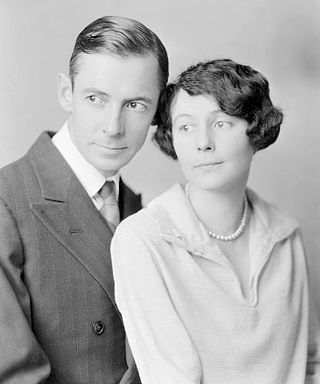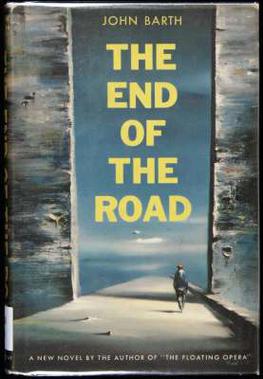Titan most often refers to:

Historical fiction is a literary genre in which a fictional plot takes place in the setting of particular real historical events. Although the term is commonly used as a synonym for historical fiction literature, it can also be applied to other types of narrative, including theatre, opera, cinema, and television, as well as video games and graphic novels. It often makes many use of symbolism in allegory using figurative and metaphorical elements to picture a story.

Vurt is a 1993 science fiction novel written by British author Jeff Noon. The debut novel for both Noon and small publishing house Ringpull, it went on to win the 1994 Arthur C. Clarke Award and was later listed in The Best Novels of the Nineties.

John Simmons Barth was an American writer best known for his postmodern and metafictional fiction. His most highly regarded and influential works were published in the 1960s, and include The Sot-Weed Factor, a whimsical retelling of Maryland's colonial history; Giles Goat-Boy, a satirical fantasy in which a university is a microcosm of the Cold War world; and Lost in the Funhouse, a self-referential and experimental collection of short stories. He was co-recipient of the National Book Award in 1973 for his episodic novel Chimera.

Postmodern literature is a form of literature that is characterized by the use of metafiction, unreliable narration, self-reflexivity, intertextuality, and which often thematizes both historical and political issues. This style of experimental literature emerged strongly in the United States in the 1960s through the writings of authors such as Kurt Vonnegut, Thomas Pynchon, William Gaddis, Philip K. Dick, Kathy Acker, and John Barth. Postmodernists often challenge authorities, which has been seen as a symptom of the fact that this style of literature first emerged in the context of political tendencies in the 1960s. This inspiration is, among other things, seen through how postmodern literature is highly self-reflexive about the political issues it speaks to.

Giles Goat-Boy (1966) is the fourth novel by American writer John Barth. It is a metafictional comic novel in which the universe is portrayed as a university campus in an elaborate allegory of both the hero's journey and the Cold War. Its title character is a human boy raised as a goat, who comes to believe he is the Grand Tutor, the predicted Messiah. The book was a surprise bestseller for the previously obscure Barth, and in the 1960s had a cult status. It marks Barth's leap into American postmodern fabulism.

Edwin DuBose Heyward was an American author best known for his 1925 novel Porgy. He and his wife Dorothy, a playwright, adapted it as a 1927 play of the same name. The couple worked with composer George Gershwin to adapt the work as the 1935 opera Porgy and Bess. It was later adapted as a 1959 film of the same name.

In Greek mythology, the Shirt of Nessus, Tunic of Nessus, Nessus-robe, or Nessus' shirt was the poisoned shirt (chiton) that killed Heracles. It was once a popular reference in literature. In folkloristics, it is considered an instance of the "poison dress" motif.

Self-insertion is a literary device in which the author writes themselves into the story under the guise of, or from the perspective of, a fictional character. The character, overtly or otherwise, behaves like, has the personality of, and may even be described as physically resembling the author of the work.

Lost in the Funhouse (1968) is a short story collection by American author John Barth. The postmodern stories are extremely self-conscious and self-reflexive, and are considered to exemplify metafiction.

The End of the Road is the second novel by American writer John Barth, published first in 1958, and then in a revised edition in 1967. The irony-laden black comedy's protagonist Jacob Horner suffers from a nihilistic paralysis he calls "cosmopsis"—an inability to choose a course of action from all possibilities. As part of a schedule of unorthodox therapies, Horner's nameless Doctor has him take a teaching job at a local teachers' college. There Horner befriends the super-rational Joe Morgan and his wife Rennie. The trio become entangled in a love triangle, with tragic results. The story deals with issues controversial at the time, such as sexuality, racial segregation, and abortion.

The Sot-Weed Factor is a 1960 novel by the American writer John Barth. The novel marks the beginning of Barth's literary postmodernism. The Sot-Weed Factor takes its title from the poem The Sot-Weed Factor: Or, a Voyage to Maryland. A Satyr (1708) by the English-born poet Ebenezer Cooke, about whom few biographical details are known.

Chimera is a 1972 fantasy novel written by American writer John Barth, composed of three loosely connected novellas. The novellas are Dunyazadiad, Perseid and Bellerophoniad, whose titles refer eponymously to the mythical characters Dunyazad, Perseus and Bellerophon. The book is an example of postmodernism, which can be seen in its metafictional content and its incorporation of stylistic elements that go beyond the traditional novel genre. It shared the U.S. National Book Award for Fiction with Augustus by John Edward Williams.
A floating timeline is a device used in fiction, particularly in long-running comics and animation, to explain why characters age little or not at all while the setting around them remains contemporary to the real world. The term is used in the comics community to refer to series that take place in a "continuous present". Floating timelines are also used when creators do not need or want their characters to age, typically in children's books and animated television shows.

LETTERS is an epistolary novel by the American writer John Barth, published in 1979. It consists of a series of letters in which Barth and the characters of his other books interact.
The Literature of Exhaustion is a 1967 essay by the American novelist John Barth sometimes considered to be the manifesto of postmodernism.

Sabbatical: A Romance is a novel by the American writer John Barth, published in 1982. The story is centered on a yacht race through the Chesapeake Bay. Barth's narrative was inspired by the death of ex-CIA officer John Paisley.

The Floating Opera is a novel by American writer John Barth, first published in 1956 and significantly revised in 1967. Barth's first published work, the existentialist and nihilist story is a first-person account of a day when protagonist Todd Andrews contemplates suicide.

The Last Voyage of Somebody the Sailor is a novel by American writer John Barth, published in 1991. It is a postmodern metafictional story of a man who jumps overboard from a modern replica of a medieval Arab ship and is rescued by sailors from the world of Sinbad the Sailor. Eventually he makes his way to "Baghdad, the City of Peace", and finds himself in the stories of Sindbad and Scheherazade. The novel makes use of a challenging double-stranded narrative and a rich prose style.

Coming Soon!!! is a novel by the American writer John Barth, published in 2001.













